March 10th, 2014
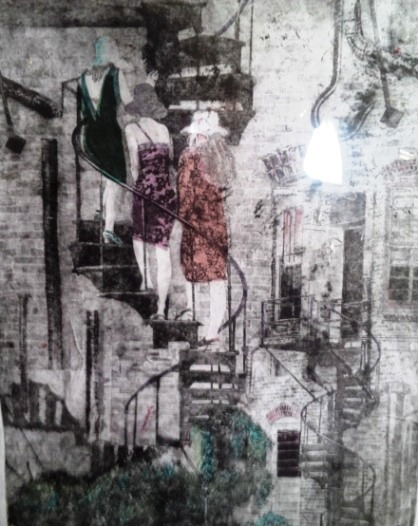
“Some things are destined to be — it just takes us a couple of tries to get there.”
― J.R. Ward, Lover Mine
This lovely painting of three women came to me in the 1990’s and I remember wondering if that was me and two other women I hadn’t met yet. It hung in my living room for years, but when I redecorated, I put it away. When I stumbled across it recently in the basement, I realized that I did meet these women, around 10 years later. And when we met, we had work to do. And as it turns out, we had a film to make.
I loved the image of these women, dressed up but navigating what seemed to be a difficult and winding climb up a narrow staircase, and navigating that climb in heels. When I saw it again, a couple of months ago, with fresh eyes, the woman in the middle of the group seemed like Kit Gruelle, in her signature purple, who is the guide, teacher, and advocate in the film “Private Violence”. Kit is also a survivor, and she became my friend.

The woman with the long blond hair reminded me of Cynthia Hill, the director of the film. We are now more than colleagues; we’re friends as well.

I’d always thought of myself as the woman in the green dress, simply because I liked the dress, I love green, and it looked like something I’d wear. The painting, by a wonderful artist named Earline McNeil Larsen, is called “Conspiraling Women”.
I met Kit Gruelle, in Del Mar, California in 2005. Cynthia Hill came later, in North Carolina. There was a immediate familiarity about both of these women. It was that click that goes off in your head or the shivers that go through your body when something significant happens or is about to happen. These two mainstays of the “Private Violence” feature film and documentary project stood there talking to me prior to a 2010 fundraiser in Chapel Hill, where Gloria Steinem, one of our early supporters was to speak. Those shivers came on even stronger. I thought at the time about the power of the number 3 (three women, the triple goddess symbol) and hoped that that unseen power could move this film forward. At that point, we knew it would take a long time to get the whole thing launched. And it did.
There were times when it seemed like letting it all go might be easiest. The other film, “Bully”, that the Waitt Institute for Violence Prevention supported took about two years from start to launch at the Tribeca Film Festival in 2011, and the funding came in quickly once it got going. That didn’t surprise me, as bullying had become a high profile topic, and that story needed to be told. I’m glad it was. But it was a tougher go for “Private Violence”. That didn’t surprise me either. The title of the film tells why. It’s something we still tend to keep in the dark, hidden away.
Along the long path to getting it done, though, more and more earth angels, women and men, kept appearing showing up at the right time and right place with perfectly timed grants, encouragement, connections and support that we desperately needed. I can’t name them all here, but each one provided vital support.
The three of us have been through a lot together, and separately, in the years that it took to complete the story. We each have been through challenges, both in life and in getting the film to its January Sundance opening. Cynthia has given birth to two daughters since we all met. We come from three different worlds, and sometimes meshing those worlds isn’t easy. We laughed together, and cried together, but we’ve stuck together and I’m glad we made it up that narrow and winding staircase in those high heels. We know that at the top of that staircase is another, and another. The film is only a small part of that work so many people do every day, but it felt good to be able to pause, and know that we’d made that first climb.
As I was writing this, I remembered that I had bought two paintings, and went down to the basement and took this shot of the companion piece to “Conspiraling Women”.
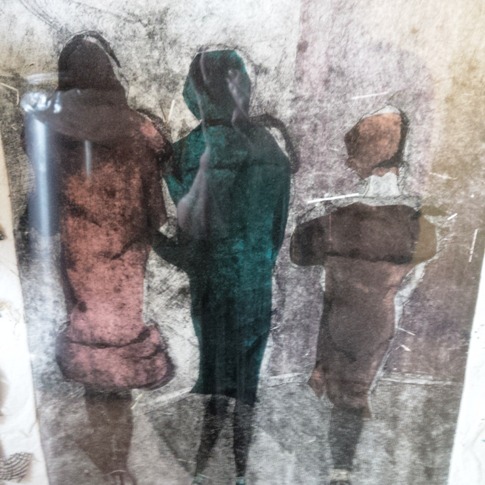
It turns out that the name is “Triple Alliance”. I don’t know who the women in this painting are, but that doesn’t matter. When I see the title and the image, it reminds me of the alliance of all the women who came together for this. Perhaps the three above symbolize the extraordinary trifecta of three of the women featured- Deanna Walters, Stacy Cox, and Jean Kilpatrick. They demonstrate the strength of survivors and advocates, both in the film, and in their lives. Or the piece could stand for the three women who founded Chicken and Egg Pictures, who believed in us at a crucial point. I don’t know, because there are so many more who over the years found us, joined us, and reached out. Both paintings remind me that women are strong, but even stronger when we come together. We’re stronger yet when we don’t give up on something we need to do or say. The paintings are both upstairs now, in a favorite room, full of light. I think they’ll stay there.
Comments (0)
November 4th, 2013

Updated March 18, 2024
“These aren’t domestic disputes, they are about criminals attacking crime victims” Anne Jones, Author of “Next Time She’ll Be Dead“
This caught my eye a few years back.
The headline read, “MAN ARRESTED IN DOMESTIC DISPUTE“.
It went on to describe the case of a 30 year old man who strangled his girlfriend until she passed out several times over a two day period, and left her hospitalized with numerous internal injuries and bleeding.
Is this a “dispute?” And is this type of headline unusual? Not so much. The word is still used widely, as are the equally bad terms “domestic disturbance”, and”domestic altercation”. Even worse is “crime of passion” or my personal non- favorite “love triangle”.
I’m with the Virginia Sexual and Domestic Violence Alliance when they say this in their site’s media education literature, “A dispute is akin to a disagreement or argument; it implies equal power. Intimate partner violence, on the other hand, is a serious, cyclical pattern of abuse and unhealthy behavior meant to control an individual. Referring to such incidents as “domestic disputes” takes away from its seriousness. It also implies an isolated incident, rather than a pattern of abuse. Call it domestic violence or intimate partner violence.”
Here’s just a sample of headlines I’ve run across in the past 24 hours from March 17th and 18th 2024: The first from Clarendon Hills, Illinois was just about the worst. “A person died in a domestic disturbance”. No, the person was murdered.
Madison Police Dept. arrest suspect for alleged domestic disturbance involving knife
There are hundreds, if not thousands of those headlines and leads to be found. These are not bad people writing these stories. My husband, a former journalist, tells me that he was trained to use the term “domestic dispute”. as are many print and broadcast journalists who could use some additional education in how we refer to the hundreds of thousands of incidents and the thousands killed each year in this country alone. These are violent crimes and some are murders. Some facts…
Safe Horizon | Domestic Violence Statistics & Facts
National Domestic Violence Statistics
- 1 in 4 women and 1 in 7 men will experience severe physical violence by an intimate partner in their lifetime. (CDC, 2017)
- 1 in 10 women in the United States will be raped by an intimate partner in her lifetime. (CDC, 2010)
- Approximately 16.9% of women and 8.0% of men will experience sexual violence other than rape by an intimate partner at some point in their lifetime. (CDC, 2010)
- Data on sexual violence against men may be underreported.
- An estimated 9.7% of women and 2.3% of men have been stalked by an intimate partner during their lifetime. (CDC, 2017)
- Nearly half of all women and men in the United States will experience psychological aggression by an intimate partner in their lifetime. (CDC, 2017)
- Over half of female and male victims of rape, physical violence, and/or stalking by an intimate partner experienced some form of intimate partner violence for the first time before 25 years of age. (CDC, 2010)
Knowing that, can we move to writing and reporting about it with the harsh reality in mind? There is a good bit of material I found today from the Virginia Sexual and Domestic Violence Action Alliance that could help. http://www.vsdvalliance.org/#/public-policy-media.
As my friend and colleague Kit Gruelle, a subject, advocate, and special adviser to the HBO documentary “Private Violence” said to me in commenting on this story, “Using the proper terminology, even if it is difficult to do, will force us to grow up and see this violence in all it’s horror.” Amen to that, Kit.
Let’s not soften these horrendous crimes by misnaming them. Let’s call them what they are.
Comments (8)
October 16th, 2013

Daisy Coleman
“At the end of the day, what’s so frustrating and dismaying—about this story, as well as the others I mentioned earlier—is this pattern….The girls become pariahs. They wear the scarlet letters of our time.” Emily Bazelon
We’ve heard it all before in the past year. There was the brutal and recorded rape case in Steubenville, Ohio in March of 2013. In April, 2013 we heard of suicide victim Rehaeh Parsons’ case of an alleged gang rape in Nova Scotia. Now, the past few days, we have the case of a Daisy Coleman, a 14 year old girl whose family was driven from their home following her alleged rape by a politically connected young man who was never prosecuted.
The details in the case are emerging. The Kansas City Star tells of a family led by a widowed mother and her four children, who were essentially bullied out of Maryville, Missouri, after Daisy told her mother of her assault by a 17 year old football player Matthew Barnett, grandson of former MO State Representative Rex Barnett. Despite compelling evidence, charges were dropped against Barnett and another 17-year-old accused of recording the sexual encounter on an iPhone. http://www.kansascity.com/2013/10/12/4549775/nightmare-in-maryville-teens-sexual.html,
Melinda Coleman, Daisy’s mother, a veterinarian and widow of a doctor who was killed in a car accident six years earlier, was fired from her job at Maryville’s Southpaws Veterinary Clinic. Daisy was suspended from her high school’s cheerleading team, suffered depression and had a suicide attempt. The whole family, including Daisy’s brothers, suffered vile attacks on social media from both kids and adults, and in a bizarre finale to their nightmare, their house in Maryville, by then for sale as the family had moved, burned down.
We know that victim blaming is a powerful and potent weapon used to discourage reporting of sexual assaults. That fact is as old as time. I went to high school in the early 70’s, and knew victims of rape, who would never come forward, and now they never will. No one wanted to go through the ordeal. There are thousands of Daisy Coleman’s of all generations out there, but she and her family came forward. What they reportedly went through goes even beyond the term “victim blaming’ into a different realm. We now see the victim as a pariah.
Emily Bazelon, who is quoted above, reference’s Nathaniel Hawthorne’s famously told story of Hester Prynne in the 1850 classic “The Scarlet Letter” in a recent piece in Slate. http://www.slate.com/blogs/xx_factor/2013/10/14/maryville_rape_case_the_horrifying_details_of_what_happened_to_daisy_coleman.html. The book is not a tale of rape, but it is a story of a good woman from Salem Massachusetts in 1642, who becomes pregnant by the town pastor and is shunned by her community. As punishment for being found guilty of adultery, she must wear a scarlet “A” on her dress as a sign of shame. In a particularly harrowing scene, she is forced to stand on the scaffold for three hours, exposed to public humiliation. The dynamics are vastly different in the cases of Daisy and Hester, yet both are made pariahs, both are shunned, both take the blame.
After the Steubenville case, I wrote a piece for Huffington Post, called “The Upstanders”. I lamented the fact that bystanders did nothing. In that case, and in this case, though, it went beyond doing nothing. Community members that could have been a support system actively targeted the victims and the victim’s families. http://www.huffingtonpost.com/cindy-waitt/the-upstanders_b_2994409.html
Considering this horrific new story of Daisy and her family, I was happy to see that, once again, the army of social media, an army that can serve as tormentor as well to the Daisy Coleman’s, has begun to stand up on the right side. A Facebook page is up and running, hundreds of stories like this one are appearing, and there is a twitter stampede starting, even backed again, as in Steubenville, by the group Anonymous.
We can no longer do nothing, we can do something, even if it’s just to sign our name in support of a young girl and her family, who never should have had to suffer this brutal crime, nor it’s hideous aftermath.
Update 10/15/2013: The Lieutenant Governor is calling for a grand jury..
Sadly, I update this story… January 7, 2014 http://www.washingtonpost.com/blogs/she-the-people/wp/2014/01/07/daisy-coleman-alleged-rape-victim-attempts-suicide-again/
And again…. January 9, 2014. http://www.cbsnews.com/news/daisys-mom-disappointed-over-charge-in-maryville-case/
Read the rest of this entry »
Comments (2)
October 10th, 2013
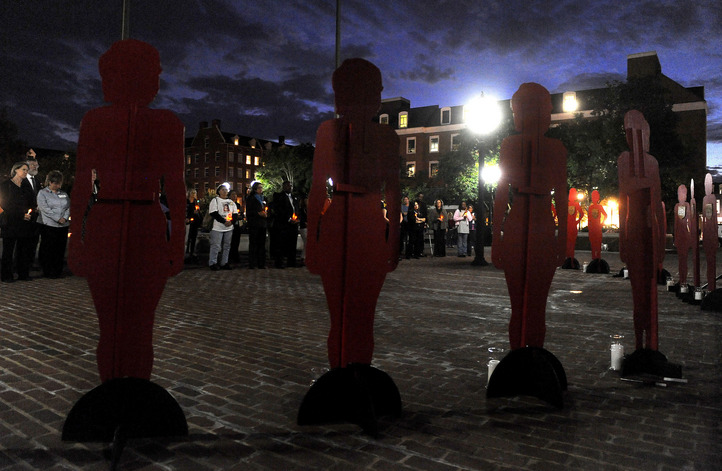
Too many victims
“If the numbers we see in domestic violence were applied to terrorism or gang violence, the entire country would be up in arms,and it would be the lead story on the news every night.”– Rep. Mark Green
Terrorism is defined as ” the systematic use of violent terror as a means of coercion”. We tend to define terrorists by incident- the September 11 attackers, the Boston bombers, the Oklahoma City bombers, the group behind the Kenyan mall attack, and on. The horrific September 11th, 2001 attacks gave rise to what we now call “the war on terror”, a war that may never end. September 11th also gave rise to a United States Government Department of Homeland Security. Between FY 2001 – FY2009, $850 billion was spent on the War on Terror, according to this source. http://useconomy.about.com/od/usfederalbudget/f/War_on_Terror_Facts.htm. After over 3,000 citizens were killed that day, our elected leaders understandably pledged to do everything in their power to keep our citizens safe.
And yet, consider the millions of victims who are terrorized each day, and terrorized where they live. Here’s a snapshot of the national landscape
- 1 in 4 women and 1 in 7 men will experience severe physical violence by an intimate partner in their lifetime. (CDC, 2017)
- 1 in 10 women in the United States will be raped by an intimate partner in her lifetime. (CDC, 2010)
- Approximately 16.9% of women and 8.0% of men will experience sexual violence other than rape by an intimate partner at some point in their lifetime. (CDC, 2010)
- Data on sexual violence against men may be underreported.
- An estimated 9.7% of women and 2.3% of men have been stalked by an intimate partner during their lifetime. (CDC, 2017)
- Nearly half of all women and men in the United States will experience psychological aggression by an intimate partner in their lifetime. (CDC, 2017)
- Over half of female and male victims of rape, physical violence, and/or stalking by an intimate partner experienced some form of intimate partner violence for the first time before 25 years of age. (CDC, 201
Representative Green’s opening statement speaks volumes in how we see and deal with the perpetrators and victims of family violence. The people who commit these acts are criminals, though they are usually called “perpetrators”. But, there’s more to this. If terror is “the systematic use of violent terror as a means of coercion”, then let’s call these people what they are. Terrorists.
Lucy Berrington, in a Women’s E-News report in 2012, said this, “Domestic abuse is a form of terrorism that comes from within our society, resulting in mass casualties and extremely high costs. But for it’s victims, no big budget homeland security effort exists. “
She’s got that right. Others agree.
“Framing domestic abuse as ‘everyday terrorism’ helps us understand how fear works,” said Rachel Pain, the author of an English study called “Everyday Terrorism: How Fear Works in Domestic Abuse”.
“Not only do the victims of both forms of terrorism share the same painful consequences–the terrorists use the same tactics,” said Trese Todd, president of a Seattle nonprofit that addresses domestic violence.
In my years working in violence prevention, talking to survivors, advocates, and educators, I realize that they all are saying the same thing. The dynamics of intimate partner violence are eerily similar to the dynamics of terrorism , and they all know it and speak to it. The tactics used by abusers are addressed in our new documentary “Private Violence”, a film that finally brings answers to the age old question, “why doesn’t she leave”? She and her children are being terrorized, that’s why.
I’m choosing to re frame the conversation and remember that terrorists don’t always hijack planes and don’t always come equipped with bombs capable of mass destruction. Their weapons may differ, but they are terrorists, and they are in your town, they are on your street, and they may be just next door.
For more on what you can do to help prevent violence see http://www.futureswithoutviolence.org/section/get_involved/.
If you are in immediate danger, call 911.
If you are being hurt by your partner, it is NOT your fault. You deserve to be safe and healthy. For help and information anytime, contact:
National Domestic Violence Hotline
www.ndvh.org 1-800-799-SAFE (7233)
TTY 1-800-787-3224
National Sexual Assault Hotline
www.rainn.org
1-800-656-HOPE (4673)
National Teen Dating Abuse Helpline
www.loveisrespect.org
1-866-331-9474
TTY 1-866-331-8453
Comments (2)
September 29th, 2013

“Our challenge today is to explain how Congress evolved into our national nutcase.” Gail Collins, “Congress Cracks Up”, September 27th, New York Times.
I’m not sure how many ways I can say I agree with Ms. Collins, but suffice to say, I agree. Some of the members of the 113th Congress is acting probably more irrationally than any we’ve seen in decades. But, from what I see and what I’ve learned over the years, I’d say they aren’t acting just like “nutcases”, they’re acting like what they are…bullies.
In October of 2012, I wrote a piece for Huffington Post called “Who Did You Bully Today?”http://www.huffingtonpost.com/cindy-waitt/who-did-you-bully-today_b_2006802.html. In it, I listed types of adult bullying that are not only getting in the way of efforts to keep kids from brutalizing each other, but are actively giving them bully lessons. Among the groups I listed was the United States Congress.
This is what I said then about our elected officials..”There are some great politicians out there, dedicated and devoted to the public good, and many are active supporters of violence prevention. But, as a group, “hired” by us to work together in essentially a two-party system, they would earn a great big “dysfunctional” label and earn it easily. Let’s ponder this. Imagine a company where half the employees have as a stated goal the overthrow of the CEO. In this place, the employees have two camps, and many in both camps work not only on obstructing the work of the other camp every day, but are also featured in the media trashing the other camp on a daily basis as well. Would you invest in that company? We do. …I’m hoping they’ll gaze into their collective mirror and look at what’s not working in their own halls. I think many of them would like to see more civility in the process of legislating.”
I await this civility, and have a feel I will be “awaiting this civility” for a long time. We currently face a government shutdown and the tactics currently being used by the “shutdown” gang are textbook bully tactics.
Here’s what I’ve learned about the types of workplace bullies from years of working with our Waitt Institute for Violence Prevention partners ,Workplace Bullying Institute founders Drs. Gary and Ruth Namie; and from studying the work of the late workplace bullying activist Tim Field.
The first four types come from the Drs. Namie, http://www.workplacebullying.org/the-drs-namie/, and the last four come from Tim Field http://www.bullyonline.org/workbully/
See if the behavior of our people on the Hill doesn’t sound like the types of schoolhouse nemesis we’ve all faced.
1) The Screaming Mimi. These are the specialists in “the outbursts”. Some of the rants are well timed, and some are just uncontrolled. Either way, it’s not the most effective tactic, although they rarely know that. They’re the classic “slam them into the locker” types. They tend to lose their temper at each other and sometimes the host in double screened news show interviews. It’s fun to watch for a few minutes, until you change the channel because really nothing of value is being heard or said.
2)The Constant Critic- Haven’t we all experienced the “know it all”? They rarely know it all, but they’ll let you know they do, both on the floor and on the networks. Like Downton Abbey’s dowager countess, “I am never wrong”, and the elementary school tattle tale, it’s always someone else’s fault. Always.
3)The Two-Headed Snake– I like to think of these folks as the “divide and conquer” champions of the playground. The “enemy of my enemy is my friend” tactic is at work here. Backstabbing is their game and they do it well.
4)The Gatekeeper. This one is my personal favorite when it comes to Congress. If you can’t do something yourself, then keep someone else from doing anything at all. Obstruction, obstruction, and more obstruction. Nothing gets done, and they like it that way.
5. The Attention Seeker. The “grandstanders”! The speech makers that everyone starts to tune out are in it for themselves. They love the attention, they love the press, they love to be noticed. They’re the class clown with a mean streak, and the show off that no one likes. They don’t play well with others, because it’s all about them.
6. The Wannabe. These are the Hill dwellers who just aren’t very competent. Knowing this, they’ll make sure others look as clueless as they are. It keeps the focus off their deficiencies. If little Johnny isn’t the best student in class, he’ll make sure little Susie and little Bobby look worse than he does.
7. The Guru. In their minds, they are above all criticism and above reproach. They may be experts, but in their minds, they’re the only experts. Possible “teacher’s pet”. This is the kid with their hand raised-all the time.
8. The Sociopath. This is the most dangerous type of bully, with no empathy, no loyalty, no bonds. Like many sociopaths, they are master manipulators, and can be charming in getting to their goal, which is always to look out for themselves. Period.
Does any of these sound like some people we know up on The Hill? And we want our children to stop bullying?
Ms. Collins asks in her excellent piece http://www.nytimes.com/2013/09/28/opinion/collins-congress-cracks-up.html“”So, what do you think is wrong with these people?” I would simply answer, see above.
Comments (3)
September 3rd, 2013

Hello from the cornfields of Iowa
“I’m happy wherever I go, whatever I do. I’m happy in Iowa, I’m happy here in California.” Ashton Kutcher (Some of us are happy here too, Ashton”). Have you noticed he seems like kind of a nice guy? Not surprised.
Dear Huffington Post,
I really like your site. In fact, sometimes I even write for your site. But, the other day I ran across a piece from your site on Twitter about a quest for style in Iowa. Apparently, this was such a strange notion that the Onion had to do their own version, which was pretty good, and in some cases, pretty accurate. http://www.theonion.com/articles/iowa-fashion-week-begins,31579.
I’m glad you visited, though. I actually liked the video piece, full of charm and good characters, but your written piece left out some of that charm. So, readers all over the U.S. were left with just these photos as a representation of all of us here in the fields of dreams…. http://www.huffingtonpost.com/2013/08/29/iowa-fashion-style_n_3831853.html?utm_hp_ref=mostpopular
So, with your permission, (can I have permission?) I’ll use your photos but add a couple of my own.
Here’s your picture of where we shop….

You really should have shown Walmart. We have some good ones here. Photo courtesy Huffington Post.
But sometimes I shop in places that aren’t in malls, with, like, cool brick walls and everything…

Like this place…called Studio 427, not in mall. Courtesy Studio 427, Sioux City
or this place
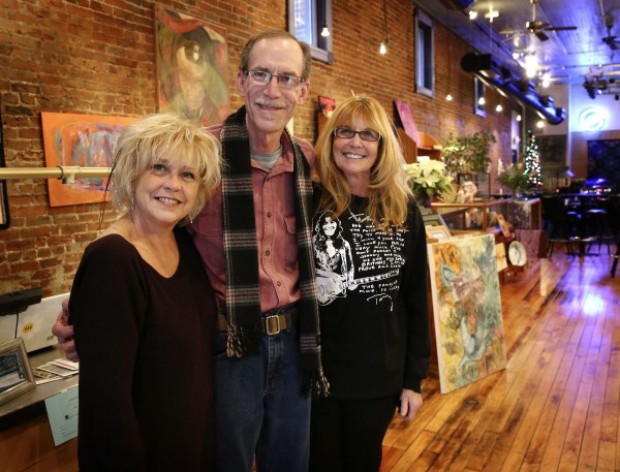
Indigo Palette, also in Sioux City, Iowa. Here, I’ll prove to you that this isn’t in a mall….

Not a mall. So, there’s only two or three places that aren’t a mall, I still thought I’d show them to you.
Then we proceeded to the type of hair salon, we all frequent, from your story…

You kind of picture Aunt Bea here, don’t you? Photc courtesy Huffington Post.
Here’s my hair salon, if you’d like to add this to your follow up story…

This doesn’t suck too bad. Bliss salon, Sioux City. Not in mall. Have you noticed I’m trying to get you to come to Sioux City? Photo courtesy Bliss Salon
Not done yet, but neither were you, so we’ll move onto the clothing styles, particularly our choice of denim… Here’s yours..

Here’s your Iowa denim fashion statement. I actually kind of like overalls, and they work on this guy. Photo courtesy Huffington Post again. I would imagine that probably only about .001 percent of us wear these but thank you anyway…

I found one just about like this…so you were darn close here… Photo courtesy Huffington Post again

Ok, a bit different, but not bad…. Photo courtesy La Ventura and the Weekender, yes, Sioux City again.

Two young Sioux City kids wishing they had overalls… I think I’ll find them and buy them some. Photo courtesy La Ventura and The Weekender.
Here’s another jeans picture from Iowa, taken of my husband during a protest.
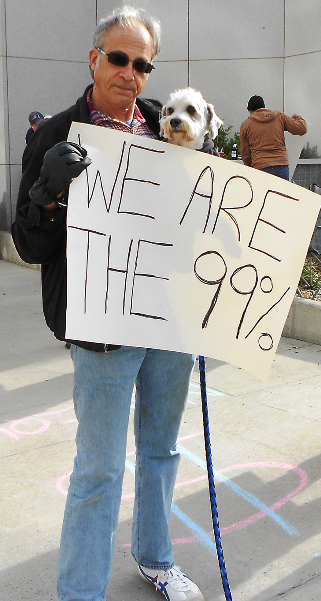
Oh, shit, are these dad jeans?
But wait there’s more….
I loved your beard picture of the guy that lived in Paris and moved back to Iowa. I can’t find a damn thing even close in Sioux City, so you win big here….
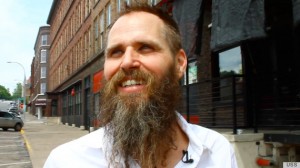
This beard is awesome, great job. Photo courtesy Huffington Post again. You guys are great and so is this beard..
Nothing remotely like it that I could find in Sioux City, so here’s two guys I know, with rather short beards.
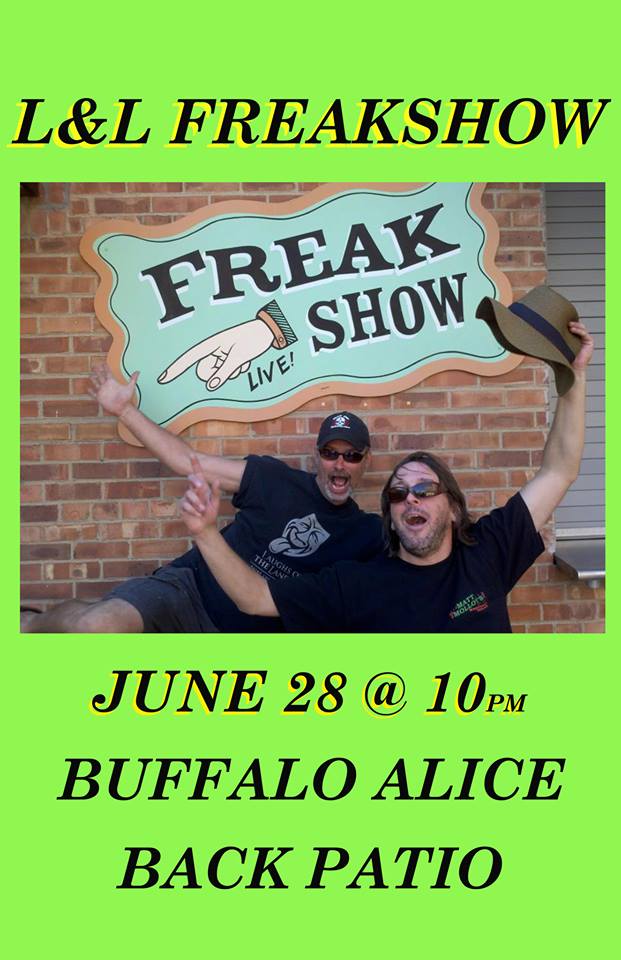
Here’s two friends who apparently need to work on their beard length if they want to be a bit freakier than they are. Photo courtesy Garie Lewis and Mike Langley.
I do get it, though. It’s easy to pigeonhole Iowa. I was the executive producer of a documentary called “Bully”, partially filmed here in my home town. My friend, Lee Hirsch, who I love, didn’t show much of Iowa. In fact, Sioux City looked like one bus, one train track, and a school. Here’s a shot…

Sioux City in “Bully”, footage courtesy of Lee Hirsch, and I think the Weinstein Company too. Thank you, Mr. Weinstein and thank you for buying our film too. 🙂 Will you please buy my next documentary? Call me….

Heck, we’ve got bridges and everything here in Sioux City, and cars too….
Sometimes, half the town gets together for a big party close to the fourth of July. There’s usually about 30,000 of us and some good bands too, so I am inviting you to visit and get kind of a cross section of types, because, you’ll get the general idea that we are a bit more nuanced here in the heartland than people think.
Here’s the party….

Gosh, we can fit about half the town here…. and just the denim fashions alone will give you much to work with. Photo above and below courtesy Saturday in the Park.

These folks aren’t from here, but we let people like this play here and no one has to pay to get in. So, join us next year, ok? I like Melissa’s jeans.
I’ll close by saying that we come in all shapes and sizes here in flyover America, so do come visit again, particularly in Sioux City. We need you. Poor Sioux City is doubly not blessed by not only being in a flyover state, but for having the unfortunately airport designation SUX. I’m not making that up. So, on your purchase of a ticket from whatever coast on our one and only airline, you can see it yourself. And, you’ll get a free gift basket, with items such as this…


All SUX photos courtesy Sioux City gifts….
and my personal favorite…

So, come visit and be nice, or as Glinda once said, be gone, before I drop a Walmart on you. 🙂
Most Sincerely Yours,
Cindy Waitt
This is me and my family. When we’re in California, we wear dark glasses, so we can pretend we are cool too.
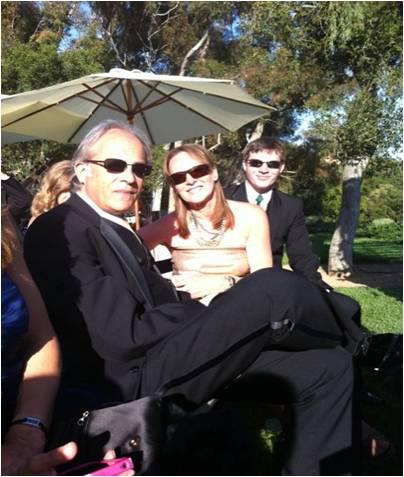
And finally, can I still write for you?
Comments (14)
August 12th, 2013
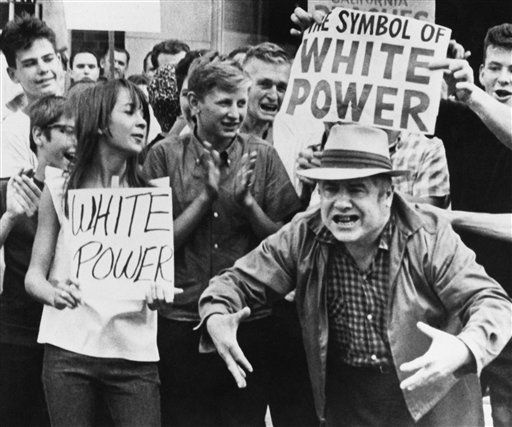
This was happening when I was in elementary school.
“At some point in our lifetime, gay marriage won’t be an issue, and everyone who stood against this civil right will look as outdated as George Wallace standing on the school steps keeping James Hood from entering the University of Alabama because he was black.” George Clooney
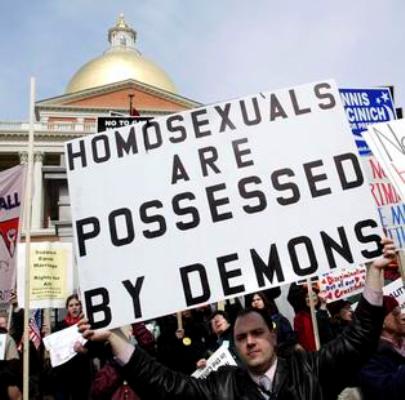
And this is still happening now….
Do you ever watch a documentary on the civil rights movement of the 1950’s and 60’s and cringe when it comes to scenes of furious white people hurling stones, taunting, and overall verbally and physically assaulting movement activists? In 2013, it seems ludicrous, shameful, and yes, embarrassing. If you haven’t, do it. And go ahead, cringe. We should.
If footage from then seems like coverage of the Dark Ages, consider this. If you are over 50, that outward display of hatred was happening in your lifetime.
Today’s children routinely study atrocities like the Holocaust, the Salem Witch trials, and the treatment of African Americans and Native Americans, as well as women, in our country. If they aren’t studying them, they should be, and often. It’s simply history now, that discipline that takes us back to another time while we see the actions and decisions of our ancestors from modern sensibilities. The behaviors seem almost insane from our point of view today, particular the behaviors of people living in our lifetime, in our country, and perhaps in our own cities.
Jump forward 50 years to 2013 to the marriage equality movement and the overall movement that started out of a bar called the Stonewall Inn in Greenwich Village in New York in 1969. We’ve come a long way. Just a few headlines from this year:
Supreme Court DOMA Decision Rules Federal Same-Sex Marriage Ban Unconstitutional
THE END OF “EX-GAY’ CONVERSION THERAPY.
Poll: Support for gay marriage hits high after ruling
As my friend and colleague Jackson Katz said years ago, “That train has left the station”. And it has. But, as a person who’s been involved in some movements, I know that for every push, there’s a “push back”. And oh, what a push back.
Let’s just take my beloved hometown, Sioux City, Iowa. I sing it’s praises all the time, but not on this one. In fact, Sioux City has a rather disturbing history of “the push back”. Here’s a few highlights and a few stars of the anti equality bunch that our own children and grandchildren may be reading about 50 years from now…or sooner.
1950’s, Sioux City, Iowa: As Neil Miller writes about in his classic “Sex Crime Panic”, described here. “Following the brutal murders of two children in Sioux City, Iowa, in 1954, police, in an attempt to quell public hysteria, arrested 20 men whom the authorities never claimed had anything to do with the crimes. Labeled as sexual psychopaths under an Iowa law that lumped homosexuals together with child molesters and murderers, the men were sentenced to a mental institution until cured.” If I wasn’t there in the mid 50’s, I was on the way…
2004, Sioux City, Iowa, from The Advocate “The Sioux City, Iowa, city council has rejected a proposal to make it illegal to discriminate on the basis of a person’s sexual orientation. The council voted 4-1 Monday against adding gays and lesbians to the current city law, which makes it illegal to discriminate against people in jobs, accommodations, and housing on the basis of race, creed, color, national origin, religion, ancestry or disability.The Human Rights Commission asked the council to add sexual orientation to that group of protected classes. Mayor Dave Ferris and Councilmen Marty Dougherty and Jason Geary said they voted against the measure based on their religious beliefs involving homosexuals. Councilman Craig Berenstein said he voted no because he wanted more time to study the proposal.Councilwoman Karen Forneris cast the only vote in favor of adding sexual orientation to the law. Five Iowa cities have included sexual orientation in their ordinances—Ames, Cedar Rapids, Davenport, Des Moines and Iowa City. That time I was there. A group of us stood outside city hall to protest that one. I should have done the same in the mid 1990’s when a religious group objected to my having an LGBT section in my store. A new council finally went along with adding sexual orientation in 2008, as the state of Iowa had already added it.
2010, Sioux City’s own Pastor Cary Gordon and the Cornerstone World Outreach were leaders in the efflort to have Iowans oust three Iowa Supreme Court justices whose ruling was part of a 7-0 unanimous vote that legalized same sex marriage in the state of Iowa. The three justices were ousted, but later received the “Profiles in Courage” awards from the Kennedy Center in 2012.
2011, Sioux City’s own, Bob Vander Plaats and The Family Leader gained national recognition for its pledge, “The Marriage Vow: A Declaration of Dependence upon MARRIAGE and FAMILY”, which it asked 2012 presidential hopefuls to sign. Vander Plaats himself also gained recognition, being referred to in one news post as a “kingmaker.”
I hope as our descendants study the history of our nation, as well as our own home town, some of these things will be looked at with new eyes and looked at hard. My sense is that the cringe factor is and will be strong, as it should. Just recently there has been a controversy concerning the appointment of a gay man, Scott Raasch, to the Sioux City Human Rights Commission, following the uncovering of some unpleasant comments Raasch made to anti gay rights Pastor Cary Gordon three years ago. Gordon has asked for Raasch’s removal. http://siouxcityjournal.com/news/local/govt-and-politics/cornerstone-pastor-calls-for-new-sioux-city-human-rights-commissioner/article_04263e87-485c-5697-921a-e0729251192e.html The city council has just yesterday stated that Raasch will stay on the commission. That was the push, I await breathlessly for the push back.
I also await the day when we, as a country, and as fellow humans recognize and learn from our own cringe worthy actions and behaviors, that gay rights and marriage equality are simply human rights, and deserve our full and unqualified support.
Comments (4)
August 5th, 2013

John and Tommy Bolin together in 1976.
Written in August 2013.
“Tommy Bolin’s guitar playing was so ahead of its time that we are now just feeling the significance of it.” Joe Bonamassa
“Tommy was a musician who wanted to play rock and roll and wanted to put a smile on the faces of people who loved rock and roll. Tommy’s music is still doing that.” John Bolin
Thursday night, August 1st and what would have been Tommy Bolin’s 62nd birthday, my husband and I and my brother Norm and a friend had dinner and then went to see “The Tommy Bolin Memorial Fan Jam”. Walking into the room, for me, was like walking into a time machine. Some of the same faces, older, more lined, were there, as well as musicians like John Bartle and John Bolin, who we’d first heard 40 years ago, were on the stage. The Jam is part of a three day Tommy Bolin Fest put on by his younger brother John each year in Sioux City.
A high school dropout who left Sioux City at 16, Tommy Bolin was an extraordinary guitar virtuoso who played with the likes of the James Gang and Deep Purple, but tragically succumbed to a drug overdose at the height of his fame at 25 in 1976. He also embarked on a solo career, collaborated with Billy Cobham, inspired several tribute albums, and yes, made the cover of “Rolling Stone”. I remember the day entertainment columnist Rona Barrett covered his death on ABC and seeing his picture on the front page of the Sioux City Journal. We didn’t have that many celebrities come from our part of the world, and Tommy was not only a rock star, he was our rock star.
He looked the part. I only saw him once, I think it was 1975. He was lean, he had amazing long wild black hair, and he was, in a word,… beautiful. His brother, John, the second of the Bolin brothers, looks a lot like him. A accomplished musician himself, John is the only surviving member of the Bolin family. His parents, his brother Tommy, and his younger brother, Rick are all gone, and John has made it his business to keep the memory of Tommy and his family alive.
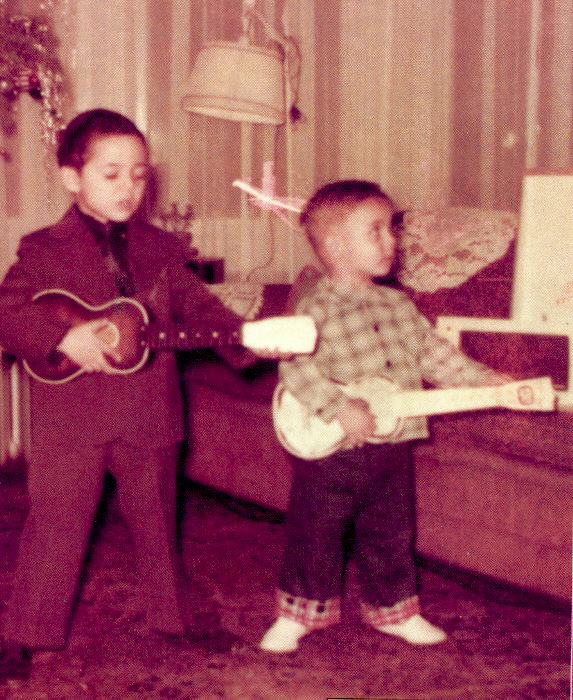
Tommy and John as children.
I had coffee with John the other day. We go back 40 years, to high school, 1972. John was, and remains, a good friend of my brother Norm and all the family.
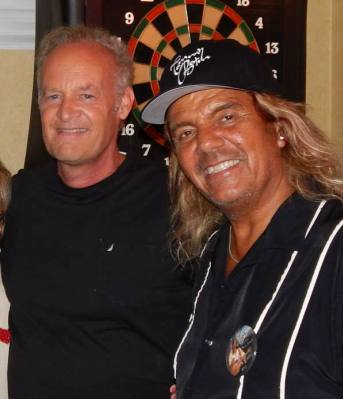
John and Norm, August 1st.
I remember picking friends up after school at the north door of Central High school. John had the rock star looks with his mane of rock star black hair, and dark handsomeness. He was always a kind man, with an enormous smile and a gentle nature. He still is. We met to discuss the continuation of the “Tommy Bolin Memorial Fund”, a fund started by the family to give back to the community where he was born. John takes it seriously, as he does the annual fest.
I understand John in ways that others probably don’t. As the sister of two brothers who found early fortune through Gateway Computers, films, and other business ventures, I know what it’s like to be in a family that was in the public eye.
John looks so much like Tommy, is a fine musician himself and has played with any number of nationally known bands both with Tommy and on his own. But I have all three siblings, who I love dearly and a mother who is still with us. Johnnie lost both parents and two brothers.
At the Bolin fan jam, I had a moment of strong “deja vu”. It happened when the band played ZZ Top’s “Jesus Done Left Chicago”. I looked around the room with the familiar faces at the tables and on the stage and I looked at my brother, Norm. The scene was eerie, so much like the 70’s that it took me back. The room was dark, masking the aging of its inhabitants, and just for a moment, I felt 18 again.
As “keeper of the flame” of his famous brother, I realized that John brought that moment to me. Music and its mood making can do that. Author Rob Sheffield put it well when he said, “The times you lived through, the people you shared those times with — nothing brings it all to life like an old mix tape. It does a better job of storing up memories than actual brain tissue can do. Every mix tape tells a story. Put them together, and they can add up to the story of a life.” Music WAS the story of Tommy Bolin’s life, as it’s the story of John’s. And the music he bring us each year in honor of his brother reminds us of our own story, and like Tommy, for a moment we are all still, forever young.
Comments (6)
August 1st, 2013
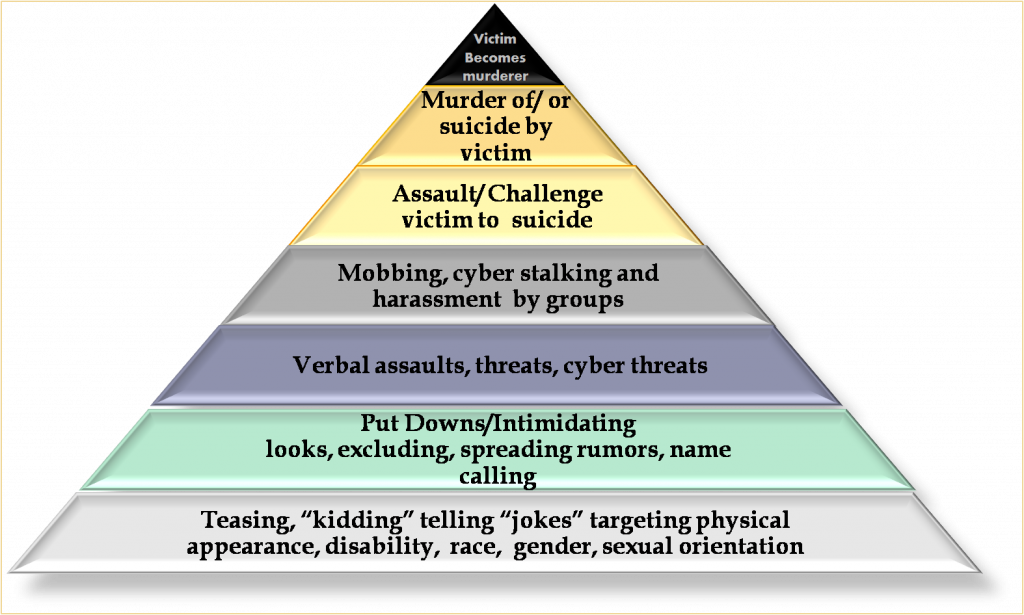
“Nonviolence means avoiding not only external physical violence but also internal violence of spirit. You not only refuse to shoot a man, but you refuse to hate him.” Martin Luther King Jr.
It’s always been my feeling that we don’t come out of the womb with hateful thoughts. As Rogers and Hammerstein said in South Pacific, “You have to be carefully taught”. Having worked in violence prevention for many years, I found something my colleague Dr. Alan Heisterkamp uses frequently in training young people. It’s called “the pyramid of violence”. It’s a brilliant tool, and it’s more than academic theory. There are too many real life examples of this pyramid.
I use this pyramid above when I talk about bullying. In the documentary “Bully”, Lee Hirsch and Cynthia Lowen highlight 5 cases that all started out with level one bullying and moved up the pyramid to, in two cases, lead to the victim’s suicide. David Long, father of Tyler Long, tells the story of kids at school taunting Tyler and telling him to “go hang himself”. Tyler hanged himself in his Georgia home at the age of 17. In some extreme cases, the victim may act with violence not only against self, but others.
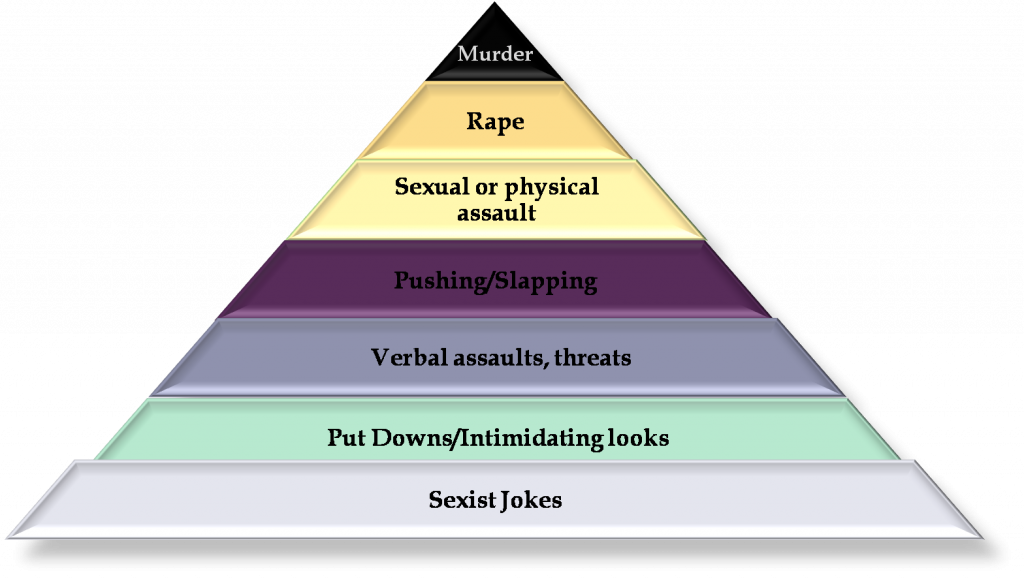
The pyramid of domestic and sexual violence
This pyramid above is used to demonstrate the escalation of violence in domestic violence cases. One is highlighted in HBO documentary, ‘Private Violence”. Domestic violence usually starts with words and escalates from there. In at least 3 cases a day in America, the violence escalates to murder. Janet, whose family was interviewed for the film, knew that her husband was capable of killing her. In her case, she was killed at the age of 42 in December of 2009 in her North Carolina home. When we repeat “rape jokes”, call women “sluts” a la Limbaugh, we are putting down half the planet. Degrading women makes it easier to see them as less and As Gloria Steinem says, “if you say that half of the human race is less than the other half, which is a lie, the only way to enforce that lie is violence”.
It can get worse. No one could have imagined that a modern developed Western European nation could have perpetrated mass killings in the mid 20th century. It was led by a mad man named Adolp Hitler, but many in that nation followed, and followed blindly. The pyramid below demonstrates how the process evolved. Adolph Hitler didn’t just get elected one day and suddenly announce a master plan to exterminate the Jews. That process took years and started with words until it reached what Hitler called “The Final Solution”.
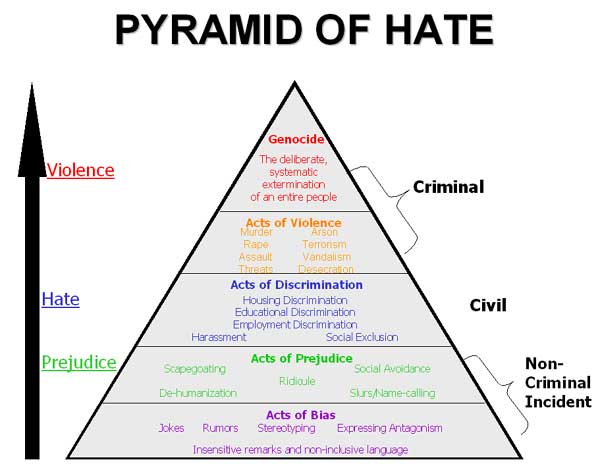
None of this is new. From the “witch” burnings in Medieval Europe (most of the victims being women), to the Spanish Inquisition, to 1990’s Rwanda, and even in our country, with the systematic removal of Native Americans from their lands, humans have found ways to believe that hating others for their race, their religion, their gender and their sexual orientation is justified and therefore, acceptable.
Psychotherapist Howard Halpern, in a brilliant New York Times piece in 1995, gave a spot on summation of gradual escalation of hate and violence. He said, “ Social psychologists and demagogues have long known that if ordinary citizens are to be provoked to violent actions against individuals or groups of fellow citizens, it is necessary to sever the empathic bond with those to be attacked by painting them as different and despicable. We are unlikely to harm a friendly neighbor because she has strong views about equal rights for women, but if we call her a “femi-Nazi,” she becomes “the other” — evil, dangerous, hated. We are unlikely to harm the couple down the block who are active on behalf of protecting endangered species, but if we call them “environmental whackos,” they become “the other” — weirdos who must be vilified and suppressed as enemies to “normal” Americans. When our shared humanity with those with whom we disagree is stripped away, it becomes acceptable to blow them up. The answer is certainly not to censor such speech, but those who recognize this danger must challenge it wherever it exists, even in those with whom we politically agree.”
As Halpern said, we must recognize this danger and challenge it wherever it exists. It exists close to home for me, whether it be Iowa Congressman Steve King asserting that immigrants are drug mules or anti gay activist, Iowan Bob Vanderplaats who called homosexuality a “public health” risk, to the collection of Republican state senators in my state who opposed an anti bullying conference for students by what they called ” groups who pervert the Bible, teach our youth to engage in dangerous behavior”.
Sticks and stones do break our bones, and it starts with words that hurt.
Comments (2)
July 28th, 2013
By Eric Blumberg

Eric Blumberg is an award-winning radio talk show host who also has gained acclaim as a reporter and columnist for several radio stations and local weekly newspapers. Born in New York City in 1952, he received his B.A, in Media Studies at Hunter College and spent two years at the graduate school of journalism at the University of Texas in Austin. He spent the majority of his broadcast journalism career in Austin, where he was recognized four times as the city’s best radio talk show host. Blumberg has taught journalism at Austin Community College as well as English as a second language and writing at Western Iowa Tech Community College in Sioux City. He now lives in Sioux City, Iowa with his wife, Cindy Waitt. He has three daughters and one stepson.
To U.S. Residents Living Outside Iowa’s Fourth Congressional District:
As a resident of Sioux City, Iowa and a member of the city’s Human Rights Commission, I want to offer all of you my sincerest apologies for the continued stupidity of my U.S. Congressman, Steve King.
His most recent hateful comments regarding those who would benefit from the Immigration Reform Bill are not necessarily those of his constituents. Nonetheless, you might get the impression that those Iowans of King’s 5th district are mindless bigots in the fashion of our Congressman.
Iowans are fair people, who, by and large, do not condemn other people simply based on their race, gender, sexual orientation, religion or, in this case, their current immigration status.
While I do understand what the Congressman is trying to say, I don’t understand why he chose to say it in the fashion he did.
Subsequent to his initial remarks from this July, he took the floor of the Congress to explain himself more thoroughly. In that statement, he, once again, alluded to his belief that the overwhelming majority of those minors who would receive a path to U.S. citizenship are working for Mexican drug cartels in an effort to supply us with the illegal substances we crave.
King stood by his statement that for each valedictorian there are 100 drug mules, adding that there cannot be any doubt of his beliefs since they are backed by logic and scientifically empirical data.
To me, that means that for every 101 undocumented teens living in the U.S., 100 are criminals. I find that hard to believe. However, if this is so, I want statistical proof. Not a guess or an assumption based on personal opinion, but mathematical certainty based on numbers derived from a credible source rather than out of his ass.
I’m well aware the 5th District voters spoke in 2012 and re-elected him by another large margin, however, that doesn’t mean we can’t speak up when faced with unrelenting ignorance and idiocy.
I’m also aware there is no recourse here in Iowa to recall King and am also aware he is too stupid to realize how wrong he is. Thus, you will never receive an apology from him.
The best we can do here in Iowa’s 4th District is to apologize for him and trust the rest of the country does not look too harshly on us since we are not bigots, but simply a group of inherently good people represented by one.
Comments (2)
June 19th, 2013
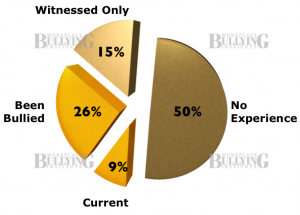
The 2010 Workplace Bullying Survey, courtesy Workplace Bullying Institute
“I think adults need to know they’re doing the same thing. It’s not just kids. There are adults that are out there bullying, and they need to be kind.” Ellen DeGeneres
As a supporter of school bullying prevention programs for almost 15 years, I am encouraged. More and more states have passed anti bullying laws, more school systems have begun implementing programs, the reception of the documentary “Bully” has been overwhelming, and we’ve finally collectively decided that the “kids will be kids” excuse isn’t working anymore. As thirty percent of students in the United States are involved in bullying on a regular basis either as a victim, bully or both and over 13 million kids are suffering from bullying, the movement needed to happen, and it needs to continue. Thankfully, as the “Bully” team went through the process of making the documentary, we found fierce advocates. They came from everywhere. Kids, parents, teachers, the media, celebrities, and Congress on both sides of the aisle stepped up and spoke out.
But, where are we when the mirror turns to us big kids? I’ve found less support there, and it doesn’t surprise me. It’s harder to turn the spotlight on ourselves. A Huffington Post piece I did in October, 2012, called “Who Did You Bully today?” http://www.huffingtonpost.com/cindy-waitt/who-did-you-bully-today_b_2006802.html, made the point that until we stopped bullying each other, we won’t see the results we want to see from our kids. I named multiple sectors of adults (including me) who bully, from the home (the first role models kids have, and the most important place to stem violence), to the workplace, to Congress, to cyberspace, and yes, the constant, mind numbing barrage of reality shows. A lot of these big boys and big girls in all of these places continue to not only not be kind, but to be brutal to each other on so many of our adult “playgrounds and school yards”. I’ve written about the link between violence in the home and violence in school, and the data backs it up. But, as the workplace, for us, is similar to our schoolyard, where we interact, socialize, work, play, learn, grow, and spend much of our waking hours, I decided to check into that again and see just how we are doing.
It’s not good. As you can see above, 35% report being bullied at some time in their work life, and another 15% witnessed it. Putting the numbers together, WBI says, with a well place exclamation point, “An astonishing 54 million Americans directly experience it!”. I get the exclamation. That’s abysmal news. The Waitt Institute for Violence Prevention actually co-sponsored the first national survey with WBI and Zogby in 2007, and those results were similar, and disheartening.
“Bully” explores the mental, physical, and emotional toll on the victims and their families. It’s hard to watch Alex being brutalized, and the despair of the Longs and the Smalleys, who suffered the cruelest loss-the suicide of their children. We don’t have a film like that to show damage from the workplace, but it’s there. The late Tim Field, an early advocate of workplace bullying prevention, said, ” Nothing can prepare you for living or working with a sociopathic serial bully. It is the most devastating, draining, misunderstood, and ultimately futile experience imaginable.”.
Here’s a slice of what it looks like, according to WBI. Is this happening to you, or someone in your workplace?
- Verbal abuse
- Offensive conduct/behaviors (including nonverbal) which are threatening, humiliating, or intimidating
- Work interference — sabotage — which prevents work from getting done
- Is driven by perpetrators’ need to control the targeted individual(s).
- Is initiated by bullies who choose their targets, timing, location, and methods.
- Requires consequences for the targeted individual
- Escalates to involve others who side with the bully, either voluntarily or through coercion.
- Undermines legitimate business interests when bullies’ personal agendas take precedence over work itself.
- Is akin to domestic violence at work, where the abuser is on the payroll
- Constant criticism
- Mobbing or targeting by a group
It’s classic bullying, and looking at the list, eerily similar to what can happen to children. The outcome looks similar to what children experience as well. Here are the consequences to our bodies and our minds according to a WBI online survey in 2012. “The top 15 health problems from bullying, ranked from most to least frequent, were:Anticipation of next negative event; Overwhelming anxiety; Sleep disruption (hard to begin/too little); Loss of concentration or memory; Uncontrollable mood swings; States of agitation or anger; Pervasive sadness; Heart palpitations; Insomnia; High blood pressure (hypertension); Obsession over personal circumstances; Intrusive thoughts (flashbacks, nightmares); Loss of affect (flat emotional responses); Depression (diagnosed); Migraine headaches”
It’s real, it’s pervasive, and all of it needs attention, just as we’ve started attending to our kids. I have hopes that the current school age generation may learn early what we adults haven’t. I also have hopes that because of the anti school bullying and violence prevention movement, we can give today’s children the social and emotional tools to recognize bullying in themselves and in others. But, if we continue to treat each other this way, wherever we interact as grown ups, can we continue then to expect more from our kids? Let’s learn to model respect, kindness, and decency. Kids watch us, they listen to us, and we can make a difference. But, let’s look in the mirror first, and go from there .
For more information, visit these sites….
Comments (0)
June 12th, 2013

Eric and me…2011
In 2009, at 52, I found myself suddenly single. It felt right, and I was starting to get more used to being alone, and I’d done a lot of work on myself. And yet, I got to thinking that now that I’d grown up a bit, I wouldn’t mind having someone else to share the ride of life with me.
So, I did what some other intuitive people I’d heard about do, when they were ready, and the time was right. I made a list. The list of qualities you’d like in a partner looks different in your 50’s, and happily so. I’d had enough time to know what I DIDN’T want. That went on the list. And then I really thought about what I DID want. I thought I’d lost it, but I came across it recently. I’d typed it up on parchment paper, added a personal touch or two, and put it in my kitchen window. Then I waited on the universe to bring it. The universe did bring it, about two months later.
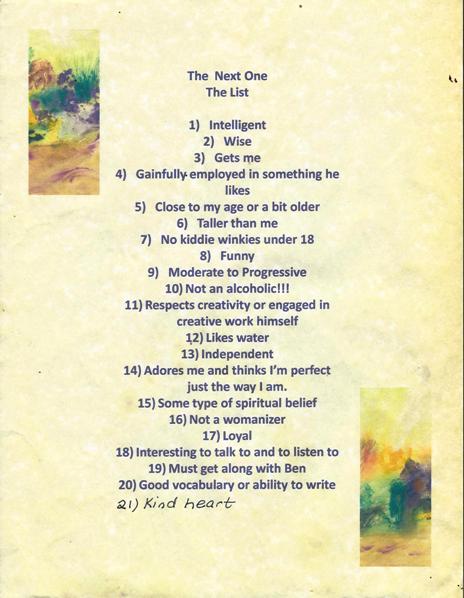
Notice the add- on at the end, which should have been a no brainer. And taller than me?, that’s different, and it’s not that I don’t like kids, I just don’t want to raise any more. And I don’t really call them kiddie winkies, my friend does. She’s English and they talk funny.
After playing Wendy to a whole crew of Peter Pans, complete with the Lost Boys, I wanted someone who had earned his big boy pants and felt comfortable wearing them. One of the first things I said to him early on in the courtship was “you’re a grown up”. And he replied, “That’s one of the nicest things anyone ever said to me.” I liked that, and I liked him. A lot.
Today is our 2nd wedding anniversary, and as much as I sometimes wish he’d shown up in our twenties, I don’t think he was supposed to. So, I went to my computer this morning and got this little document from him.
Dearest Love
This paean goes out to the one who has made my life complete. Never before has a man felt as fortunate as I. You have made me a whole man because you are a whole woman. Your tenderness and understanding far exceeds my inherent worth, yet there you are with arms outstretched, always will to embrace me despite my faults and shortcomings. For me, I couldn’t have scripted a better way to complete my life than spending the rest of it with you.
Happy Anniversary
Now, that’s one of the nicest things anyone has ever said to ME. He IS a grown up, he’s the love of my life, and…see number 19, he can write too.
Comments (6)
June 9th, 2013
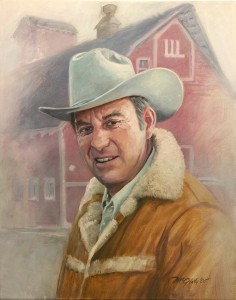
Painting of my father by Mick McGinty
“Inside a barn is a whole universe, with its own time zone and climate and ecosystem, a shadowy world of swirling dust illuminated in tiger stripes by light shining through the cracks in the boards.” Carolyn Jourdan
My brothers’ company, “Gateway 2000”, later to become just “Gateway” didn’t start in a barn, as they loved to say in those days… a lot. It started in September of 1985 in a small farmhouse on the land where that barn stood. Regardless, those young men saw it every day. A early, famous ad “Computers from Iowa?” showed that barn and my brothers, and I’d guess that’s why the phone started ringing. It was real, it was unique in those days of the early Silicon Valley companies, and it was my father’s land, and my father’s barn. With that and the cattle that land once had, a brand was built. It was a big barn, and what it stood for became a big brand, at least for a time.
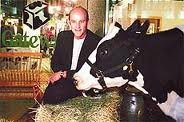
Ted and his talking cow
The barn meant a lot to my father who purchased the land in the 70’s, as did the land. My father’s relationship with the land was interesting, for a white man of his time. He told me that it wasn’t something he just owned, it was simply his job to take care of it while he was here. Strangely, my brother, Ted, said something like that just two weeks ago. It was Native American land once, taken from them by someone, as it sadly happened when the white men showed up here in this corner of Northwest Iowa. The land had had a few owners by the time my father had it, I don’t know all of the history and I don’t know what year the barn was built. But it was an impressive barn, big and dark red and always beautifully maintained by my father. It almost took your breath away when you went up over the hill and saw it for the first time.

My son Ben and niece Stephanie, early 90's.
My father’s family had a long history in the Loess Hills of Iowa. The first ancestors, William Palmer Holman and his wife Lois Grant Holman, father of Ella Waitt, arrived here in 1856. She died 3 months after they arrived. Her letter written home to family in Connecticut speaks of the beauty of the hills and the river, although it was a strange land for her, and she missed the comforts of the east. She was the first white woman buried in this county. http://cindywaitt.com/pilgrims-presidentsand-pioneers-looking-for-lois/ Four generations of Waitt brothers followed WP Holman in the cattle business, until my father realized that the business he once knew really didn’t exist in the same way anymore. He advised my brothers to do something else, and they did, but not without a nod to their roots. That nod to Iowa and all those barns and those cow spots as homage to those generations built a brand that one could see in many parts of the world in the 1990’s. I used to love seeing it in downtown New York and London. It said Iowa to me.
So, this past few weeks, as I’m re doing the front page of my website, I had to choose a picture, just one to keep it simple,that might speak for what I do, and what I am. I looked for something that told my story, about me, my family, my work, and how I see things. After looking at probably hundreds of pictures of my life, my work, and my family, here’s what I landed on, and that’s why I’m writing this piece.

The barn and land, over 20 years ago. The land's a golf course now, but the barn is still there.
It’s a bit blurry, as is my memory of it in those days. I’ve asked my friend Thomas, who does my changes, to make it that way. It seemed right. The barn does stand for what I’m about, I think. A peaceful setting, nature, family, and roots. Barns like that barn and the fertile land they stood on were and still are the lifeblood of Iowa, though it’s changing these days. That way of life fed a lot of families, including mine. The company that started right next to that barn made the money that we can all give back to others today. Both the land and the company are owned by others now. But the barn still stands, and to me the picture said, in 1,000 ways, this is home.
Comments (4)
May 20th, 2013
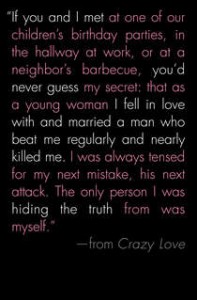
From Leslie Morgan Steiner’s book”Crazy Love”
Updated October 12, 2014
“Kit, it might be good if you’d provide a statistic. I’m no expert, but it’s my understanding that domestic violence only affects poor, uneducated people. Lawyers, doctors, and professors do not beat their wives and children.” Sociology professor to Kit Gruelle
One of the scenes I found most compelling when I was looking at footage a couple of years ago for the upcoming HBO documentary “Private Violence” is the one above. My friend, colleague, and narrator, subject and special adviser to the film, reads this from her sociology professor in a scene we hope will challenge one of the age old myths of domestic violence- that it doesn’t happen to people who grew up like me.
I was raised in a family of privilege in the 1950’s, 60’s, and early 70’s in a small city in Iowa. We had a lovely home with a swimming pool, in a pretty neighborhood. My father owned his family cattle business, my mother was a community volunteer and a member of the Junior League. My parents’ friends were CEO’s, doctors, lawyers, and “pillars of the community”. We had great vacations, summer camp, and college educations provided. We spent much of our time at the Country Club, playing with the children of those pillars of the community.
I don’t think I’d ever heard much about family violence. I’d never seen it in my home, because there wasn’t any. I don’t remember any friends who ever spoke of it. It just wasn’t discussed. As Gloria Steinem says frequently, “there was no word for domestic violence, it was just called “life”. It wasn’t a life I knew.
The first time I heard from a victim of this secret subject was when I was in my first year of college. The story was from an older woman, I’ve just called her “Emma” when I’ve told her story.
Emma was a neighbor, a woman of wealth and position, a college graduate with a lovely home, a grandmother. Emma was the May Queen at her University, where she graduated in 1922. She was knocked down by her husband in the hallway in that lovely home in the 60’s, and hospitalized with a broken back. The man wasn’t her first husband, they had no children together, and she was fortunate as she had means, owned the home, and was able to get him out of the home with the help of family. So many women aren’t that fortunate. He was never charged with anything. Few men like him were in those days.
I was stunned by her story, and was certain that this was a rare case, particularly among people like that… like us. My social work education and career opened my eyes to the scourge of family violence, the victims, the perpetrators and the kids permanently scarred who witnessed it. Perhaps this fueled my later support of violence prevention. Or perhaps it was for Emma, who had her back broken.
One of the myths of domestic violence is that there is what my friend, colleague, and long time domestic violence victim’s advocate Kit Gruelle , receiver of the rather stunning note above, calls “the typical victim”. She scoffs at that phrase. To her the “typical victim” isn’t typical, and whatever the unenlightened think it is, as she says musically, “it ain’t that”. And, it isn’t.
We still too often see “that” victim as poor, struggling, and uneducated, as did her professor, when she was completing a degree in social work. The note wasn’t written in the 1960’s. It was a couple of years ago. And though Kit says today that many of her teachers were absolutely amazing and well versed in domestic violence, this one, a PhD in Sociology, wasn’t.
When we began gathering stories for a history project of just a few of the millions of victims of domestic abuse, Kit wanted to make sure we had footage of women who’ve experienced abuse who didn’t fit “the profile”. She knew of many. She can leave the names off and tell you their stories. She found one during the filming, who not only told us her story, but told readers of story in her book “Crazy Love”, told countless interviewers, and recently told close to a million people via a TED talk. Her name is Leslie Morgan Steiner and her talk, viewed over 2,000,000 times is here. http://www.ted.com/talks/leslie_morgan_steiner_why_domestic_violence_victims_don_t_leave.html. It’s powerful, it’s honest, and it’s worth watching.
Leslie, in 2009 to CNN, summarized the attitudes some of us still have of families with power, stature, wealth, or celebrity. It was shortly after after the highly publicized story of the assault of Rihanna by Chris Brown, “ Like Rihanna, I had a bright future in my early 20s. I met my abusive lover at 22. I’d just graduated from Harvard and had a job at Seventeen Magazine in New York. My husband worked on Wall Street and was an Ivy League graduate as well. In our world, we were the last couple you’d imagine enmeshed in domestic violence.”
She’s right. We wrap a bubble around those of status, fortune, fame and privilege. We have footage from years ago of Senator Patrick Leahy, a longtime sponsor and supporter of the Violence Against Women Act, talking about that bubble. He speaks of people who don’t want to think it happens in the house next door and says, “It DOES happen in your town, it DOES happen in your neighborhood..” And it does.
Dr. Susan Weitzman, who spent years researching what she calls “upscale violence”, and authored the 2000 book “Not to People Like Us: Hidden Abuse in Upscale Marriages” http://drsusanweitzman.com/ has profiles of both victim and perpetrator on her site. She echoes much of what Kit Gruelle has to say about what Dr. Jeanne King calls “Domestic Violence, Tiffany’s Style”. There are specific challenges to this type of case, including societal disbelief, peer pressure to remain silent, and the difficulty of taking on someone with wealth, position, and power. Gruelle says, “Because their husbands are men of position and this guy has a very public persona, it adds another complex layer for the victims. Everyone in the community has their mind made up about this guy.”
As more high profile cases of abuse “Tiffany’s style” keep coming to light, it’s worth remembering that the “typical victim” isn’t so typical any more and perhaps never was. I still go to the Country Club with my mother, and I sometimes look around the jovial and gentile crowd and think about the stories that might always be hidden, that may never be talked about, but stories and experiences surely, for the victims and the families, that won’t be forgotten.
Emma, this one is for you.
Comments (8)
May 15th, 2013
To dearest Norm, with love.

Norm all dressed up for something…
“One man practicing kindness in the wilderness is worth all the temples this world pulls.”
Jack Kerouac, The Dharma Bums
“Every family needs a Norm” Eric Blumberg
Norm is my older brother, but I’m fiercely protective of him. That’s just the way it is. As very small children, he was, according to my mother, very protective of me, so perhaps I’m just paying it back. So, there you have it. If you mess with Norm, you’ll answer to me. 🙂
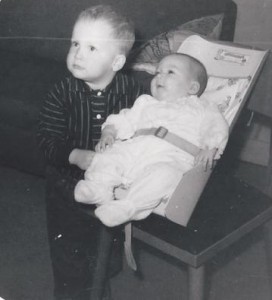
His kindness is almost pristine. His humor is legendary. His generosity is enormous, and much of the time, it’s quiet. His humble ways sometimes fool people, but underestimate him at your own peril, because his mind and his memory are razor sharp. He can be trusting, sometimes to a fault, like I am. He loves music, he loves art, he loves to fly from place to place, (unlike me), he’s way more physically fit than most people, he gathers beautiful things, and he gives beautiful things back. He’s a stellar friend, a great dad, a loving brother, and an irreplaceable human being.
My husband Eric, who as a former journalist, is a pretty decent judge of character, said an interesting thing to me one night after I’d hung up from a conversation with Norm and said something like “Oh, Norm…he’s just so sweet”. He said, “Every family needs a Norm”. They do, and every world needs a Norm too. We’re glad he’s here.
For his birthday, I’m gathering good thoughts from friends, acquaintances, and colleagues to give to him at his birthday dinner this week. Please leave a wish for Norm in the comments and tell him that you’re glad he’s here too. 🙂
Comments (26)

















































